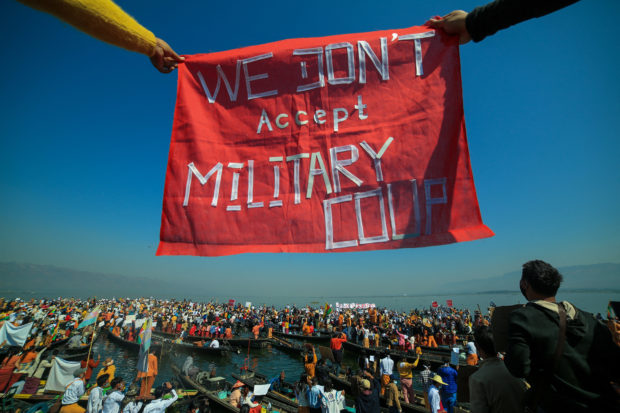Myanmar coup: 100 days of turmoil

In this file photo taken on February 11, 2021, protesters wearing traditional Shan dress take part in a demonstration against the Myanmar military coup in Inle lake, Shan state. Myanmar’s military seized power on February 1, ousting the civilian government and arresting its leader Aung San Suu Kyi — the 100 days that followed have seen mass street protests, bloody crackdowns by the junta, economic turmoil and growing international concern. Photo by STR / AFP
YANGON — Myanmar’s military seized power on February 1, ousting the civilian government and arresting its leader, Aung San Suu Kyi.
The 100 days that have followed have seen mass street protests, bloody crackdowns by the junta, economic turmoil and growing international concern.
A recap of events:
Back to the old days
The generals stage a coup on February 1, detaining Nobel peace laureate Suu Kyi and her top allies in pre-dawn raids.
It ends Myanmar’s decade-long experiment with democracy after close to half a century of military rule.
Article continues after this advertisementThe generals claim fraud in November’s elections, which Suu Kyi’s National League for Democracy (NLD) party won by a landslide.
Article continues after this advertisementThe putsch draws global condemnation, from Pope Francis to US President Joe Biden.
Walkie-talkies
Two days later 75-year-old Suu Kyi is charged with an obscure offense over unregistered walkie-talkies at her home.
Internet blocked
Resistance to the coup begins with people banging pots and pans — a practice traditionally associated with driving out evil spirits.
The junta tries to block social media platforms including Facebook, which is hugely popular in Myanmar. Nightly internet blackouts are later imposed.
Bold defiance
Popular dissent surges over the weekend of February 6 and 7, with tens of thousands of people gathering on the streets calling for the release of Suu Kyi.
Workers begin a nationwide strike on February 8.
Police fire on protesters
A young woman, Mya Thwate Thwate Khaing, is shot in the head and another person is wounded after police fire on crowds in Naypyidaw on February 9.
International sanctions
The next day Washington announces sanctions against several military officials, including Senior General Min Aung Hlaing, the army chief now in charge.
More rounds of sanctions follow in the subsequent weeks from the United States, Britain and the European Union.
New Suu Kyi charge
On February 16 Suu Kyi’s lawyer says she has been hit with a second charge, this time under the natural disaster management law.
First protester dies
Mya Thwate Thwate Khaing, the woman shot 10 days earlier, dies on February 19, becoming a symbol of opposition to the junta.
More charges
Suu Kyi is hit with two new criminal charges on March 1. Her lawyer says she is now accused of inciting unrest and breaking telecommunications laws.
Ten days later the military accuses her of accepting illegal payments of cash and gold.
Atrocities alleged
On March 11 rights group Amnesty International says it has documented atrocities by the junta including the use of battlefield weapons on unarmed protesters.
A day later a UN rights expert on Myanmar accuses the military of crimes against humanity.
Junta defends coup
The junta defends seizing power on March 25 and says it will not tolerate “anarchy” wrought by protesters.
Bloodiest day
Armed Forces Day on March 27, the military’s annual show of strength, turns into a bloodbath with more than 100 civilians killed in protest crackdowns — the deadliest single day since the coup.
‘Civil war’ warning
Violence escalates in border areas between the military and Myanmar’s numerous ethnic rebel armies — several of which have declared their support for the protest movement.
On March 31 a UN envoy calls for Security Council action to stop the country spiraling into civil war.
Secrets charge
On April 2, Suu Kyi’s lawyer announces the most serious charge laid against her — of breaching the official secrets act.
Shadow government
Ousted civilian lawmakers, forced into hiding, announce the formation of a shadow “National Unity Government”.
Asean summit
Leaders from regional bloc Asean hold a summit on the Myanmar crisis in Jakarta, and invite junta leader Min Aung Hlaing.
They agree a five-point statement calling for dialogue, an end to violence and the appointment of an envoy.
But state media report days later the bloc’s “suggestions” will only be considered “when the situation returns to stability” in Myanmar.